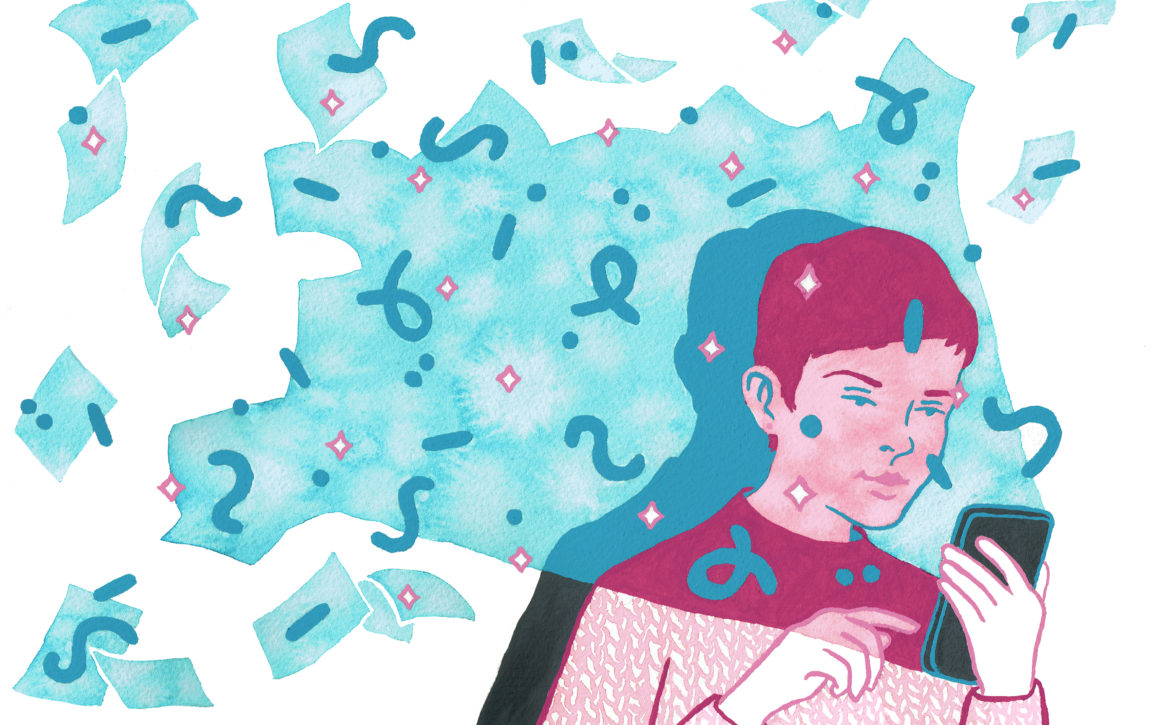
The Rise of the Very Online Novel
If an experience occurs online, how much of an experience is it really? The sociologist Nathan Jurgenson has used the phrase “digital dualism” to critique the fallacy that what happens online is less real than what happens in the analog world. A looming sense of unreality informs the notion that a friendship conducted over social media means less than a face-to-face conversation, or that online harassment isn’t as harmful as its in-person equivalent. Physical experience is seen as authentic, and frequently recommended as a break from the mediation and falseness of digital communication.This problem—call it the falsity of the screen—has also posed a problem in fiction. Over the last decade, novelists have struggled with the feeling that the internet is the opposite of narrative. The narrator of Jenny Offill’s Weather (2020) disdains social networks: “I don’t use any of them because they make me feel too squirrelly. Or not exactly squirrelly, more like a rat who can’t stop pushing a lever.” Adam, the protagonist of Ben Lerner’s Leaving the Atocha Station (2011), uses online chat, but it dulls even the most shocking experiences: His friend recounts the random tragedy of watching a woman drown while swimming in a river, telling the story through an instant-message conversation replete with interrupted messages and connection problems. The digital medium makes the horror seem less acute and underlines Adam’s alienation from his own surroundings. The lovers in Sally Rooney’s novels pour out their feelings over email, but sense there is something missing. The narrator of Lauren Oyler’s Fake Accounts (2021) is obsessed with social media and dating sites, constantly checking her profile and messages, and yet the main action of the book—her boyfriend’s faking of his own death and the narrator’s darkly whimsical sojourn in Berlin in the aftermath—lies in physical events.The writers who have so far come closest to capturing the feel of the internet in their books have channeled its chaos and incoherence. Kate Zambreno’s Drifts (2020) is a fragmented novel, whose narrator is obsessed with YouTube videos and self-googling. “There appears to be a vast referentiality everywhere,” she senses with a tinge of alarm. Olivia Laing’s Crudo (2018), perhaps the most raw and grating example of internet autofiction, is a collage of current events, Kathy Acker pastiche, a marriage story, and the clash of the established artist’s need for calm contemplation against the chaos of social media. Social media is an addiction, curse, and accomplice for the protagonist: “She picked up her laptop and leafed through the internet. Almost immediately two things annoyed her.” Twitter and Trump might be the book’s twin villains, each enabled by the other. Yet the fractures and displacements of the internet are what dress up Laing’s novel into something more than anecdotes about wedding planning, vacations, and the transatlantic bohemian lifestyle.Of all of these writers, Patricia Lockwood is the rare voice who admits to actually enjoying life online. Her first novel, No One Is Talking About This, is a book both about and of the social-media internet, responding to the ways that it has shaped writers and readers today. Composed of brief fragments, the novel is like Lockwood texting you her thoughts in so many pixelated blue bubbles, as she finds pleasure in the web’s absurdity and uses its native language joyfully to heighten her own. It’s easy enough to hate the internet, to bemoan its influence; it’s harder to contend with it as our era’s dominant mode of expression.A pioneer of online writing, Lockwood has the perfect millennial Künstlerroman backstory: The internet liberated her from a strictly Roman Catholic upbringing, living in a rectory under her father, a priest. Of her early computer use, she recalls in her 2017 memoir, Priestdaddy, “there was a portal in the corner and I could reach my hand in and get any information I wanted.” There’s a mixture of devotion and absurdity in Lockwood’s family life, or perhaps a devotion to absurdity: Her father, Greg Lockwood, served his congregation but also, the memoir implies, might have used money meant for her impending college education to buy a guitar once owned by Paul McCartney.Lockwood joined Twitter in May 2011. That year, she also placed poems in Poetry and The New Yorker, the peak of institutional credibility, but the social network is where she developed both her sensibility and her audience (currently over 96,000 followers). She is fluent in the morass of images, references, and jokes that have accrued over the past two decades of forums, MySpace, Facebook, and Twitter: LOLcats, Dril tweets, Trolley Problem diagrams, and money printers going brrrr. A whole generation has grown up steeped in this reservoir of culture—a common language that we riff on and remix daily, online and off.Tweets as a genre don’t age well, but some of Lockwood’s seem worthy of preservation, excised from their original context in the feed and given explanatory museum labels. On January 9, 2013, she tagged The Paris Review’s account in a tweet and asked, without punctuation: “So is Paris any good or not”. In a handful of words, it illustrates how social media turned old-school literary prestige into a punch line. Lockwood plays an unknowing internet rando who can occupy the same no-longer-rarefied space of publishing as the mid-century magazine, since we’re all yelling into the same semipublic square. In 2012, the digital art archive Rhizome collected Lockwood’s “Sexts” series of tweets. One sticks in mind many years after I first encountered it: “I am a living male turtleneck. You are an art teacher in winter. You put your whole head through me.” This is vintage Lockwood: animism, eroticism, and absurdity, equal parts surrealist subconscious and vernacular Americana, stretched to the limits of grammar. Lockwood is a gonzo practitioner of language, huffing commas.The impulse behind No One Is Talking About This is to try to capture and memorialize this volatile and evanescent mode of expression, with its references both obscure and shared by millions. The novel revolves around “the portal,” an internetlike construct that is both a condensation of all that exists and a sucking void that denatures anything around it. In a way, the portal is the setting; it’s the fourth word in the book and persists as a constant backdrop, both spatial and psychological. The unnamed main character is a famous writer whose work blossomed on the internet, who participates in panels and gives readings abroad, and she spends the first half of the book documenting the experience of the 2000s internet, a literary project that is described within the text: “How will we preserve it for the future—how it felt, to be a man around the turn of the century posting increasing amounts of his balls online?” In disembodied fragments of thought, anecdote, and piercing observation, we get glimpses of her life, like unsigned blog posts on an obscure website, unified primarily by Lockwood’s mellifluous tone.“Nothing will ever be funny in this way again,” a man says to the protagonist, which is true—internet culture goes stale almost immediately. Within her fragments, Lockwood offers a litany of memes without explanation: “It me,” “Did you even read the piece?,” “Charlie Bit My Finger,” “binch,” “SHOOT IT IN MY VEINS.” These ephemeral references, almost verbal tics, capture the distorting effect that Twitter has on everyone trying to exist on the platform. Attention—in the form of likes or retweets—provides an incentive to adopt its idiom, to tweak your language until it seems to propel itself through the feed, primarily by employing those memes: “It was so tiring to have to catch each new virus, produce the perfect sneaze of it, and then mutate it into something new,” she writes. (The misspelled “sneaze” being an indication of how internet humor thrives on creatively breaking words.) On Twitter all writers are stand-up comics riffing in front of a live audience, trying to get laughs, cheers, or boos. Typing into the box feels like a form of unmitigated self-expression, but Lockwood reflects how we’re really working to retrofit our words, and thus thoughts, to the machine that distributes them.Should a novel be molded by the same forces as tweets? In some ways, autofiction presents itself as a form of resistance to the digital content feed: austere, plotless, and self-referential, it can be inaccessible or alienating. Yet some of the same qualities can also make the genre ideal for the social-media era. The author is free to offer up small fragments of self, like well-produced Instagram selfies or front-facing camera monologues, and the reader gets the frisson of guessing which are true and how accurate they might be. The short, angular paragraphs—as in Zambreno or Lockwood—and the seemingly diaristic nature of the content—as in Rachel Cusk or Karl Ove Knausgaard—are well-suited to internet-shortened attention spans and a collective appetite for reality television–style, low-stakes drama. Many of these books are surprisingly entertaining and gossipy, contrary to their forbidding reputation as the literary avant-garde.But the problem remains of moving beyond the mundanity of writers thinking about their writer lives, and into deeper emotional territory. Some autofictional novelists turn to visual art for transcendence; Knausgaard often turns to nature, smoking a cigarette while contemplating mountains, forests, or clouds on the horizon. Lockwood turns to very physical, almost elemental human tragedy as a contrast to the internet.No One Is Talking About This is a diptych. The first half recounts the headspace of the Extremely Online writer, while the second half by contrast recounts the protagonist’s sister giving birth to a daughter who has the incredibly rare Proteus syndrome, meaning her life will be short. The tandem of absolute love and absolute heartbreak supplants the vaporous intoxication of social media. The protagonist goes off Twitter and devotes her time to caring for the baby and parents. The novel can be read as a stirring meditation on grief or a vicarious confrontation with the joys and risks of motherhood.It’s easy to hate the internet, to bemoan its influence; it’s harder to contend with it as our era’s dominant mode of expression.Though the substance of the novel changes, the style does not. The continued patter of text messages and meme references scattered into casual conversation suggest that even in our deepest human moments we still live partly inside the portal, following the neural pathways of the internet wherever we go. Lockwood’s wholehearted, perhaps unavoidable, embrace of the online vocabulary is more total than other novelists who include brief interpolations of chats, direct messages, or emails in otherwise smooth prose. These forms are not just how we communicate; they are now how many people think and how we exist in the world, not a limit to experience but a lens or filter for it.This is not necessarily a disadvantage for literature. It can be disorienting to read a book that has the density of Twitter, and yet Lockwood insistently makes the text glow. It’s more prose poetry than narrative; every other line seems to contain some spark of the transcendental. The protagonist’s father, vaping at a funeral, is described as “seeming to exhale great white clouds of his mother’s soul.” The protagonist’s mental state (or our societal quandary) is given in one brief line: “Already it was becoming impossible to explain things she had done even the year before.” Meme-spotting is a fun game, but it’s Lockwood’s poetic vision that animates the novel, embedded in yet not limited to the internet.One fragment in No One Is Talking About This shouts to the future, “You will understand everything about our time! And you will know nothing about us!” Every fact might be available in a digital archive, but that doesn’t necessarily entail truth. Fiction has the capacity, besides illuminating our experience in the present, to document how it feels to exist now for readers decades or centuries hence, encoding the sensibility of the moment in text. That difficult goal is rarely accomplished on purpose, like the Golden Record sent out into space to explain humanity to aliens with a series of simple diagrams. Instead, it’s by sheer, unrelenting specificity that it might become clear what it means to live at this intermediary point between what was once called real life and the portal.The novel is more effective if you share Lockwood’s frame of reference, her fluency in the portal. There is a knowingness to its first half that is undercut by the extreme pathos of its second, as if we must realize once again that the internet is not real life; no matter how many followers we might have, mortality is lurking regardless. But the moralism is not entirely convincing; Lockwood is ultimately a zealot, looking more toward an all-internet future than a half-off half-online past. One can imagine a future edition of the novel with copious footnotes for the uninitiated, the way a translated edition of The Tale of Genji from eleventh-century Japan has to explain the elaborate references of its characters’ poems.It’s a testament to Lockwood’s capacity as a writer that a line describing the full moon as a “thicc snack”—that is, deliciously large and invested with erotic potential—lands as a moment of eloquence, a gesture at the communal innovation of language, rather than a banality or inside joke. No One Is Talking About This articulates one version of lived experience now, with more authenticity than many writers who don’t venture too far outside the lines of literary acceptability, as if trying not to get their hands dirty with internet juice. Joyce Carol Oates recently critiqued the “wan little husks” of fragmented autofiction. But she did it in a tweet—one of the major contemporary formats for public writing, and one that any writer must contend with, whether for or against.
Read More


